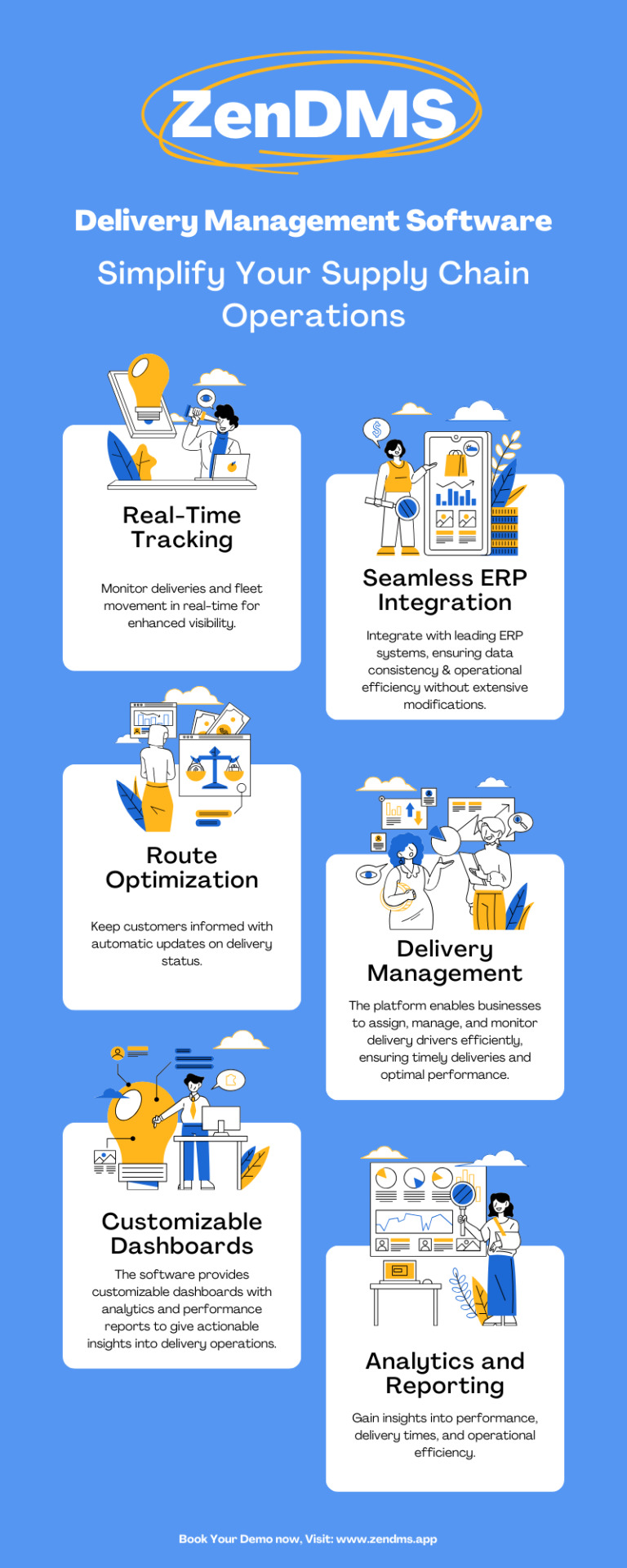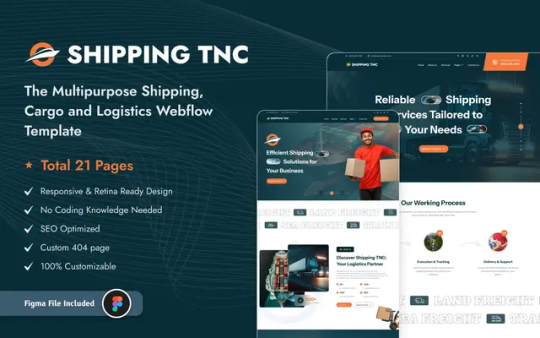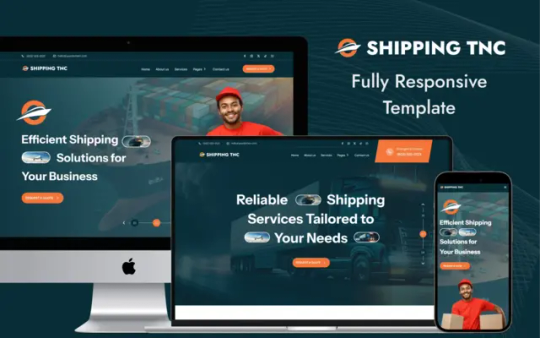#Best Tools for Supply Chain Management
Explore tagged Tumblr posts
Text

Advanced Delivery Management Software - ZenDMS
ZenDMS is a cutting-edge delivery management software designed to optimize and automate the entire delivery process. From order placement to last-mile delivery, ZenDMS simplifies logistics, ensuring accuracy, efficiency, and real-time transparency for businesses and their customers. Visit:www.zendms.app
#Top Supply Chain Software Providers#Leading Supply Chain Management Solutions#Best Logistics Software Companies#Top SCM Software Providers#Best Supply Chain Management Platforms#Leading Logistics and SCM Software#Top Supply Chain Technology Solutions#Best Supply Chain Optimization Software#Top Logistics Management Software Providers#Best Tools for Supply Chain Management#Top Supply Chain Analytics Platforms#Best Software for Supply Chain Efficiency#Top Inventory Management Software Providers#Best Vendors for Supply Chain Solutions
0 notes
Text
Are you looking for the top software device to check invoices easily and efficiently? Look no further than Fake Invoice Tracker! Our cutting-edge technology will help you keep track of all your invoices in one convenient place, saving you time and effort. Say goodbye to manual invoice tracking and say hello to an automated solution that works for you.
Visit here: https://fakeinvoicetracker.com/
#best Invoice tracker#Best Software tool to check fake invoice#Best Invoice and eway bill tracking app#Top software device to check invoice#top tracking invoice software for Business#fake invoice tracking software for supply chain management#Best Software device to check fake invoice#best online product tracking software#Best Invoice tracking Software for Small Businesses#eway bill tracking software
0 notes
Text
How To Target Your Most Profitable Customers With Retail Business Intelligence

The retail industry is highly competitive, with businesses constantly vying for customer attention and loyalty. To stay ahead of the competition, retailers need to make informed and data-driven decisions. This is where Retail Business Intelligence (BI) comes into play. By harnessing the power of data analysis and advanced analytics, Retail BI enables retailers to identify and target their most profitable customers, optimize marketing strategies, and drive business growth.
#Best BI software for Retail Industry#Retail Business Intelligence#Retail Analytics Solutions#Retail Data Analysis#Retail Performance Metrics#Retail Intelligence Software#Inventory Management Analytics#Customer Behavior Analysis#Predictive Analytics for Retail#Omnichannel Retail Analytics#Business Intelligence Tools for Retail#Retail Dashboard Solutions#Supply Chain Analytics for Retail#Retail Sales Forecasting#Retail Marketing Analytics#Customer Segmentation in Retail#Retail Competitive Intelligence
0 notes
Text
To fulfill my insufferable grey tribe quota after the antitrust post, there are some industries where the inherent monopoly is strong enough that corporate management is always going to be rent extractive in some form. Exclusive infrastructure is the most common form of this - many in the US live in broadband internet monopolies, where since private providers own the actual wire connections and building duplicate connections is incredibly wasteful, a lot of areas have only one provider who by metrics offers worse services at higher prices than in peer countries (tangent note: breaking them up nationally does nothing to address this locally) . There are still constraints - you can get hotspot internet, satellite internet, etc, these do bind prices - but they are weak.
Similar things apply to some public transit; private companies owning a subway line have a monopoly because you absolutely should not build a second line for competition's sake. They still have to price around alternate modes of transit, for sure, but depending on the city there is a "cost gap" they can extract rent from.
All of this is to say that some countries address this via price controls, and it works just fine! Tokyo's subway is managed by private companies, but the government directly intervenes in their pricing strategies, capping profit margins. Dozens of countries have price controls on various utilities. Any publicly owned company is, in a sense, doing price controls unless they are operating as a purely for-profit entity. There are costs paid by these policies, of course, but they absolutely can provide greater benefits than those costs.
Like everything else, price controls are actually just a tool in the box. They are often portrayed as theoretically impossible; that they are the slippery slope to central planning a la the USSR, and that they will necessarily blow up. If you were doing it for the whole economy it is true enough (*puts the 20 page essay on the evolution of GOSPLAN to the side with a sigh of remorse and longing*), but for individual goods it just isn't that hard to calculate the marginal price of a good, understand that price, and then subsidize it or w/e for your social end without blowing up your entire supply chain. This happens all the time, it is called a firm; all of them do internal price controls.
The problems with price controls are not that theoretical calculation debate stuff, but instead that governments just generally aren't very good at things and fuck shit up all the time. Sometimes you need to do some kind of policy anyway, for some things markets do not work at all so you just gotta do your best. But price controls are exactly the kind of thing governments fuck up the most, and so using them needs to clear an exceptionally high bar. In practice, most problems never do. There is almost always another, better way to address the problem that will fuck up less. But it is just costs vs benefits in the end, it isn't a magic box. You can price control subways, it's fine enough. Don't price control groceries, that is not going to work. Different industries, different policies.
43 notes
·
View notes
Text
Lotta words but if you read through all this you’ll find out the EPA is funding “environmental justice” initiatives in Europe
Environmental Protection Agency grant (2023)
Recipient: Organis Cooperation Develop Economique
Amount: $4,359,135
Purpose: the overarching goal of this agreement is to strengthen protection of human health and the environment across the globe in alignment with common attributes of the OECD and EPA's respective missions. Activities: the overarching goal of this agreement is to strengthen protection of human health and the environment across the globe in alignment with common attributes of the OECD and EPA's respective missions. Principal objectives for this agreement include:
- foster environmental and human health considerations in domestic and international policies; this may include work on emerging environmental risks and existing environmental challenges in areas potentially including
- but not limited to - water, air, resource efficiency, environmental justice, waste prevention and minimization, climate change mitigation and adaptation, chemicals, energy, trade, supply chain due diligence, finance, and development.
- promote coordination to develop innovative and more efficient policies to protect human health and the environment.
- enhance research and international dialogue on environmental justice considerations in national laws, policies, and other decision
-making processes, including via early and active public participation.
- promote and enhance collaboration on state of the art data and computational methods, remote sensing and sharing information, tools, and best management practices among countries and stakeholders (NGOs, international organizations, academia, citizens, etc.)
Outcomes: general activities under this agreement may include:
- preparing papers, reports, assessments and studies on topics in human health, the environment and related areas
- organizing and coordinating meetings, workshops and trainings
- developing and expanding multi-national communications, capacity building and technical assistance to advance human health, environmental protection and development goals
- facilitating information exchange among environment, development and finance ministries, including, for example, sharing expertise, experiences and lessons learned
- researching and conducting analyses and studies on the environment and related topics
- implementing other activities as needed (and mutually agreed upon) to help achieve the objectives of this agreement
- cooperating together (OECD and EPA) on the above activities, as appropriate, within the context of the OECD committees. Specific projects under this agreement will be dependent upon approved OECD programmes of work and will take into account EPA priorities, as appropriate, and may include:
- developing and disseminating good practices to address existing, emerging and likely environmental and social challenges
- developing and detailing outcome
- and output-oriented indicators, measures and goals that promote protection of human health and the environment
- identifying and researching environmental and human health impacts due to emerging challenges
- improving integration of environmental and social considerations within international development assistance efforts
- fostering information exchange, communication and capacity among stakeholders (within and among government ministries, NGOs, international organizations, academia, citizens, etc.)
- developing analyses, assessments and analytic tools that inform policy and effective management that may support the streamlining, updating or development of OECD legal instruments.
Country: France
3 notes
·
View notes
Text
Shipping TNC - Logistics Webflow Website Template: The Ultimate Solution for Your Freight Business
Logistics and transportation industry, having a strong online presence is crucial for success. Whether you’re running a freight forwarding company, a courier service, or a supply chain management business, an effective website is essential for showcasing your services and gaining customer trust. This is where the Shipping TNC — Logistics Webflow Website Template comes into play. Designed to cater specifically to logistics businesses, this template provides a seamless, professional, and fully customizable web solution.

Get It Now 👉🏻 Shipping TNC Webflow Website Template
Why Choose the Shipping TNC Logistics Webflow Website Template?
Shipping TNC is not just another website template — it’s a powerful tool designed to enhance your logistics business. Here are some of the key reasons why it stands out:
✅ Modern and Professional Design
The Shipping TNC template comes with a sleek, modern, and responsive design that creates a lasting impression on visitors. The template is structured to showcase your logistics services, company history, and customer testimonials, all while maintaining a clean and visually appealing layout.
✅ User-Friendly Navigation
A logistics website must provide users with quick access to important information such as tracking services, pricing, contact details, and service offerings. This template ensures intuitive navigation, making it easy for customers to find what they’re looking for in just a few clicks.
✅ Fully Responsive and Mobile-Optimized
In an era where mobile browsing dominates, the Shipping TNC template is designed to be fully responsive. It adapts seamlessly to different screen sizes, ensuring a smooth experience for users on desktops, tablets, and smartphones.
✅ SEO-Friendly and Fast Loading
Search engine optimization (SEO) is essential for attracting organic traffic to your website. The template is built with SEO best practices in mind, ensuring higher rankings on search engines. Additionally, it is optimized for fast loading times, reducing bounce rates and improving user experience.
✅ Easy Customization with Webflow
One of the biggest advantages of using Webflow is the ease of customization. With Shipping TNC, you can tweak every aspect of the template to match your brand identity. The drag-and-drop functionality allows you to make changes without any coding knowledge.
✅ Integrated Contact and Quote Request Forms
Communication is key in the logistics industry. This template includes built-in contact and quote request forms that allow customers to easily reach out to you for inquiries and service requests.

Visit Our 🔗 Live Preview
Key Features of the Shipping TNC Template
Homepage
Engaging hero section with call-to-action (CTA)
Overview of logistics services
Client testimonials and trust-building elements
Contact and tracking buttons for easy access
About Us Page
Company history and mission statement
Team introduction section
Core values and business philosophy
Services Page
Detailed descriptions of logistics solutions
High-quality visuals and icons for better presentation
Tracking & Quote Request Features
Integrated tracking system
Quote request form for quick pricing inquiries
Contact Page
Google Maps integration for location visibility
Simple and effective contact form
Social media links for enhanced connectivity

Who Can Benefit from the Shipping TNC Template?
The Shipping TNC Webflow template is ideal for:
Freight and cargo companies
Courier and delivery services
Warehouse and supply chain businesses
Transport and logistics service providers
E-commerce logistics solutions
How to Get Started with the Shipping TNC Template
Getting started with this template is simple:
Purchase the Template: Buy the Shipping TNC template from the Webflow marketplace.
Customize Your Website: Use the Webflow editor to personalize the template to fit your brand.
Conclusion
The Shipping TNC — Logistics Webflow Website Template is an excellent choice for logistics businesses looking for a professional, high-performing website. With its modern design, SEO-friendly structure, and user-friendly features, this template provides everything you need to establish a strong online presence and grow your business. Live Preview
Invest in a high-quality website today and take your logistics business to the next level with the Shipping TNC Webflow template!
#web development#web design#webflow#home & lifestyle#business#shipping business#design#shipping discourse#education#self shipping#shipping poll#logistics#warehousetips
2 notes
·
View notes
Text
The Future of ERP Integrations: How Low-Code and No-Code Platforms Are Changing the Game
Enterprise Resource Planning (ERP) systems’ primary goal has been to enhance business operations through streamlining critical processes such as finance or supply chain management. However, to be honest, the integration of the ERPs with other tools has not always been an easy task. It was really a nightmare for companies to integrate ERPs with the other tools. Time-consuming development cycles, huge IT costs, and some complex coding requirements totally turned ERP integrations into a mess for businesses.
But, here are low-code and no-code platforms like Odoo ERP that are quite the game-changers in ERP integrations. These contemporary remedies have made it much easier, faster, and cheaper to connect ERPs with other business applications. Let me explain to you how they are altering the landscape.

Breaking Down the Buzz: What Are Low-Code and No-Code Platforms?
Low-code platforms enable users to develop applications by designing visually with less code. They include visual design immediate productivity capabilities that promise to fast-track work for a broad spectrum of users in the organization.
No-code platforms take the automation level a little further allowing even average users like IT, ERP, engineers, business analysts, and business owners to create their systems the way they want without having to write a single line of code, and thus they can focus on tasks that matter.
By doing this, businesses just simply change their budget from standard, long, and costly ERP integrations to the cloud.
How Low-Code & No-Code Are Transforming ERP Integrations
Speed Like Never Before - Traditional ERP integrations used to be a time-consuming process and often took weeks, sometimes even months. The use of low-code/no-code tools has become revolutionary and businesses can now develop integrations in just a few days or hours. At the same time, pre-built Connectors and Templates, and automation tools certainly make the life of developers easier.
Reduced IT Dependency - In the past, ERP integrations necessitated the participation of IT teams or even external developers. Over time, the implementation of the low code/no code approach has increasingly led to newcomers getting involved. For instance, the business user can take up the role of the IT team, and as a result, the bottleneck is removed, and the tech teams do more strategic tasks.
Cost Savings Galore - The cost of hiring developers for custom ERP integrations can be hefty. On the other hand, Low-code/no-code solutions indeed offer the benefit of not needing much real developer input. As a result, such systems can be set up and maintained by non-technical employees alone.
Flexibility & Scalability - Companies are getting innovative and growing while software needs are also changing. With the help of low-code/no-code technologies, organizations can accomplish this by simply changing the integration on the go (so to speak). This way, there is no need to reinvent software every time there is a need for change.
Enforced Security & Compliance - No-code/low-code transformational strategies that are inherently secured and compliant mean that ERP integrations will be fulfilled with the required regulations hassle-free for IT teams.
Who’s Leading the Low-Code/No-Code Revolution?
Several players are shaking up the ERP integration landscape. Platforms like Odoo, Zapier, Mendix, OutSystems, and Microsoft Power Automate are leading the charge, making ERP integrations accessible to businesses of all sizes.
Is This the End of Traditional ERP Integrations?
No, it's not. Traditional coding is still very much a necessity for complex and highly customized integrations. However, low-code and no-code platforms are help in most cases to save time, money, and energy.
Odoo: A Top Low-Code ERP
Odoo is one of the best low-code ERP platforms, offering flexibility, automation, and easy customization. With its modular design and drag-and-drop tools, businesses can streamline operations without deep coding expertise.
Final Thoughts: The Future is Here
The days of painful, drawn-out ERP integrations are fading. Low-code and no-code platforms like Odoo are making ERP connectivity easier than ever, allowing businesses to focus on growth rather than technical roadblocks. If your company hasn’t explored these tools yet, now’s the time to jump in!
The future of ERP integrations is fast, flexible, and code-free—are you ready for the Odoo upgrade?
Read more: Click Here
3 notes
·
View notes
Text
How Artificial Intelligence is Transforming the Printing Industry
The printing industry is undergoing a significant transformation, thanks to the integration of artificial intelligence (AI). From automating production workflows to enhancing customer experiences, AI is helping businesses streamline operations, reduce costs, and improve efficiency. By leveraging print management software and online product designer tools, print businesses can now offer faster, more precise, and highly customized solutions.
1. AI-Driven Automation in Print Production
AI is revolutionizing the way printing businesses manage their workflows. With print management software, AI can analyze order patterns, optimize print scheduling, and reduce waste, making production processes more efficient. Automated quality control systems powered by AI can also detect errors in print files before production, ensuring high-quality output with minimal human intervention.
2. Enhancing Customer Experience with AI
Customers today expect fast, seamless, and personalized services. AI-powered chatbots and virtual assistants help printing businesses provide instant support, answering customer queries and guiding them through the ordering process. Additionally, AI-driven recommendation systems suggest the best print options based on customer preferences, improving user engagement and satisfaction.
3. Smarter Design Capabilities with AI
The integration of AI with an online product designer enables users to create stunning, print-ready designs with ease. AI can assist in:
Auto-generating design templates based on user input.
Providing real-time design feedback and error detection.
Offering intelligent color-matching and font-pairing suggestions. This ensures that even users with minimal design experience can create professional-quality prints effortlessly.
4. AI-Powered Print Marketing and Personalization
AI is enhancing print marketing by enabling hyper-personalization. Businesses can use AI to analyze customer behavior and create targeted print materials, such as direct mail campaigns customized to individual preferences. Variable data printing (VDP), combined with AI, allows businesses to produce personalized brochures, flyers, and packaging that appeal to specific audiences.
5. Predictive Maintenance for Printing Equipment
One of the biggest challenges in the printing industry is machine downtime. AI-powered predictive maintenance in print management software helps monitor the health of printing equipment, identifying potential failures before they occur. This reduces unexpected breakdowns, increases machine lifespan, and improves overall efficiency.
6. AI in Supply Chain and Inventory Management
AI-driven analytics help printing businesses optimize their supply chain by forecasting demand, tracking inventory levels, and preventing stock shortages or overproduction. This level of automation ensures smooth order fulfillment and cost savings in material procurement.
7. The Future of AI in Printing
As AI technology continues to advance, its impact on the printing industry will only grow. From real-time production monitoring to AI-powered creative tools, the future of printing will be faster, smarter, and more customer-centric. Businesses that embrace AI-driven print management software and online product designer solutions will have a competitive edge in delivering high-quality, customized printing services.
Conclusion
The integration of artificial intelligence in the printing industry is not just a trend but a game-changer. By incorporating AI-powered print management software and intuitive online product designer tools, businesses can achieve higher efficiency, reduce costs, and enhance customer satisfaction. The future of printing is smart, and AI is leading the way toward a more innovative and automated industry.
2 notes
·
View notes
Text
How to Choose the Best ERP for Engineering and Manufacturing Industry
In today’s fast-paced world, engineering and manufacturing companies face increasing pressure to deliver high-quality products while maintaining efficiency and cost-effectiveness. Implementing the right Enterprise Resource Planning (ERP) software can significantly enhance operations, streamline workflows, and boost productivity. However, with numerous options available, selecting the best ERP software for the engineering and manufacturing industry can be challenging. This guide will help you navigate this decision-making process and choose the most suitable solution for your business.

Why ERP is Crucial for Engineering and Manufacturing
ERP software integrates various business processes, including production, inventory management, supply chain, finance, and human resources. For engineering and manufacturing companies, ERP solutions are particularly vital because they:
Facilitate real-time data sharing across departments.
Enhance supply chain management.
Optimize production planning and scheduling.
Ensure compliance with industry standards.
Reduce operational costs.
Partnering with the right Engineering ERP software company ensures that your organization leverages these benefits to stay competitive in a dynamic market.
Steps to Choose the Best ERP for Engineering and Manufacturing
1. Understand Your Business Needs
Before exploring ERP solutions, evaluate your company’s specific requirements. Identify the pain points in your current processes and prioritize the features you need in an ERP system. Common features for engineering and manufacturing companies include:
Bill of Materials (BOM) management
Production planning and scheduling
Inventory control
Quality management
Financial reporting
Consulting with a reputed ERP software company can help you match your needs with the right features.
2. Look for Industry-Specific Solutions
Generic ERP software might not address the unique needs of the engineering and manufacturing sector. Opt for an ERP software in India that offers modules tailored to your industry. Such solutions are designed to handle specific challenges like multi-level BOM, project costing, and shop floor management.
3. Check Vendor Expertise
Choosing a reliable vendor is as important as selecting the software itself. Research ERP solution providers with a strong track record in serving engineering and manufacturing companies. Look for reviews, case studies, and client testimonials to gauge their expertise.
4. Evaluate Scalability and Flexibility
Your business will grow, and so will your operational requirements. Ensure that the ERP system you choose is scalable and flexible enough to accommodate future needs. The top 10 ERP software providers in India offer scalable solutions that can adapt to changing business demands.
5. Assess Integration Capabilities
An ERP system must integrate seamlessly with your existing tools, such as Computer-Aided Design (CAD) software, Customer Relationship Management (CRM) systems, and IoT devices. A well-integrated system reduces redundancies and enhances efficiency.
6. Prioritize User-Friendliness
A complex system with a steep learning curve can hinder adoption. Choose an ERP software with an intuitive interface and easy navigation. This ensures that your employees can use the system effectively without extensive training.
7. Consider Customization Options
No two businesses are alike. While standard ERP solutions offer core functionalities, some companies require customization to align with specific workflows. A trusted ERP software company in India can provide custom modules tailored to your unique needs.
8. Focus on Data Security
Engineering and manufacturing companies often deal with sensitive data. Ensure that the ERP solution complies with the latest security standards and offers robust data protection features.
9. Compare Pricing and ROI
While cost is an important factor, it should not be the sole criterion. Evaluate the long-term return on investment (ROI) offered by different ERP software. A slightly expensive but feature-rich solution from the best ERP software provider in India may deliver better value than a cheaper alternative with limited functionalities.
10. Test Before You Commit
Most ERP software companies offer free trials or demo versions. Use these opportunities to test the software in a real-world scenario. Gather feedback from your team and ensure the solution meets your expectations before finalizing your decision.
Benefits of Partnering with the Best ERP Software Providers in India
India is home to some of the leading ERP software providers in India, offering state-of-the-art solutions for the engineering and manufacturing sector. Partnering with a reputable provider ensures:
Access to advanced features tailored to your industry.
Reliable customer support.
Comprehensive training and implementation services.
Regular updates and enhancements to the software.
Companies like Shantitechnology (STERP) specialize in delivering cutting-edge ERP solutions that cater specifically to engineering and manufacturing businesses. With years of expertise, they rank among the top 10 ERP software providers in India, ensuring seamless integration and exceptional performance.
Conclusion
Selecting the right ERP software is a critical decision that can impact your company’s efficiency, productivity, and profitability. By understanding your requirements, researching vendors, and prioritizing features like scalability, integration, and security, you can find the perfect ERP solution for your engineering or manufacturing business.
If you are looking for a trusted ERP software company in India, consider partnering with a provider like STERP. As one of the best ERP software providers in India, STERP offers comprehensive solutions tailored to the unique needs of engineering and manufacturing companies. With their expertise, you can streamline your operations, improve decision-making, and stay ahead in a competitive market.
Get in touch with STERP – the leading Engineering ERP software company – to transform your business with a reliable and efficient ERP system. Take the first step toward a smarter, more connected future today!
#Manufacturing ERP software company#ERP solution provider#Engineering ERP software company#ERP software company#ERP software companies
6 notes
·
View notes
Text
Top Trends in Software Development for 2025
The software development industry is evolving at an unprecedented pace, driven by advancements in technology and the increasing demands of businesses and consumers alike. As we step into 2025, staying ahead of the curve is essential for businesses aiming to remain competitive. Here, we explore the top trends shaping the software development landscape and how they impact businesses. For organizations seeking cutting-edge solutions, partnering with the Best Software Development Company in Vadodara, Gujarat, or India can make all the difference.

1. Artificial Intelligence and Machine Learning Integration:
Artificial Intelligence (AI) and Machine Learning (ML) are no longer optional but integral to modern software development. From predictive analytics to personalized user experiences, AI and ML are driving innovation across industries. In 2025, expect AI-powered tools to streamline development processes, improve testing, and enhance decision-making.
Businesses in Gujarat and beyond are leveraging AI to gain a competitive edge. Collaborating with the Best Software Development Company in Gujarat ensures access to AI-driven solutions tailored to specific industry needs.
2. Low-Code and No-Code Development Platforms:
The demand for faster development cycles has led to the rise of low-code and no-code platforms. These platforms empower non-technical users to create applications through intuitive drag-and-drop interfaces, significantly reducing development time and cost.
For startups and SMEs in Vadodara, partnering with the Best Software Development Company in Vadodara ensures access to these platforms, enabling rapid deployment of business applications without compromising quality.
3. Cloud-Native Development:
Cloud-native technologies, including Kubernetes and microservices, are becoming the backbone of modern applications. By 2025, cloud-native development will dominate, offering scalability, resilience, and faster time-to-market.
The Best Software Development Company in India can help businesses transition to cloud-native architectures, ensuring their applications are future-ready and capable of handling evolving market demands.
4. Edge Computing:
As IoT devices proliferate, edge computing is emerging as a critical trend. Processing data closer to its source reduces latency and enhances real-time decision-making. This trend is particularly significant for industries like healthcare, manufacturing, and retail.
Organizations seeking to leverage edge computing can benefit from the expertise of the Best Software Development Company in Gujarat, which specializes in creating applications optimized for edge environments.
5. Cybersecurity by Design:
With the increasing sophistication of cyber threats, integrating security into the development process has become non-negotiable. Cybersecurity by design ensures that applications are secure from the ground up, reducing vulnerabilities and protecting sensitive data.
The Best Software Development Company in Vadodara prioritizes cybersecurity, providing businesses with robust, secure software solutions that inspire trust among users.
6. Blockchain Beyond Cryptocurrencies:
Blockchain technology is expanding beyond cryptocurrencies into areas like supply chain management, identity verification, and smart contracts. In 2025, blockchain will play a pivotal role in creating transparent, tamper-proof systems.
Partnering with the Best Software Development Company in India enables businesses to harness blockchain technology for innovative applications that drive efficiency and trust.
7. Progressive Web Apps (PWAs):
Progressive Web Apps (PWAs) combine the best features of web and mobile applications, offering seamless experiences across devices. PWAs are cost-effective and provide offline capabilities, making them ideal for businesses targeting diverse audiences.
The Best Software Development Company in Gujarat can develop PWAs tailored to your business needs, ensuring enhanced user engagement and accessibility.
8. Internet of Things (IoT) Expansion:
IoT continues to transform industries by connecting devices and enabling smarter decision-making. From smart homes to industrial IoT, the possibilities are endless. In 2025, IoT solutions will become more sophisticated, integrating AI and edge computing for enhanced functionality.
For businesses in Vadodara and beyond, collaborating with the Best Software Development Company in Vadodara ensures access to innovative IoT solutions that drive growth and efficiency.
9. DevSecOps:
DevSecOps integrates security into the DevOps pipeline, ensuring that security is a shared responsibility throughout the development lifecycle. This approach reduces vulnerabilities and ensures compliance with industry standards.
The Best Software Development Company in India can help implement DevSecOps practices, ensuring that your applications are secure, scalable, and compliant.
10. Sustainability in Software Development:
Sustainability is becoming a priority in software development. Green coding practices, energy-efficient algorithms, and sustainable cloud solutions are gaining traction. By adopting these practices, businesses can reduce their carbon footprint and appeal to environmentally conscious consumers.
Working with the Best Software Development Company in Gujarat ensures access to sustainable software solutions that align with global trends.
11. 5G-Driven Applications:
The rollout of 5G networks is unlocking new possibilities for software development. Ultra-fast connectivity and low latency are enabling applications like augmented reality (AR), virtual reality (VR), and autonomous vehicles.
The Best Software Development Company in Vadodara is at the forefront of leveraging 5G technology to create innovative applications that redefine user experiences.
12. Hyperautomation:
Hyperautomation combines AI, ML, and robotic process automation (RPA) to automate complex business processes. By 2025, hyperautomation will become a key driver of efficiency and cost savings across industries.
Partnering with the Best Software Development Company in India ensures access to hyperautomation solutions that streamline operations and boost productivity.
13. Augmented Reality (AR) and Virtual Reality (VR):
AR and VR technologies are transforming industries like gaming, education, and healthcare. In 2025, these technologies will become more accessible, offering immersive experiences that enhance learning, entertainment, and training.
The Best Software Development Company in Gujarat can help businesses integrate AR and VR into their applications, creating unique and engaging user experiences.
Conclusion:
The software development industry is poised for significant transformation in 2025, driven by trends like AI, cloud-native development, edge computing, and hyperautomation. Staying ahead of these trends requires expertise, innovation, and a commitment to excellence.
For businesses in Vadodara, Gujarat, or anywhere in India, partnering with the Best Software Development Company in Vadodara, Gujarat, or India ensures access to cutting-edge solutions that drive growth and success. By embracing these trends, businesses can unlock new opportunities and remain competitive in an ever-evolving digital landscape.
#Best Software Development Company in Vadodara#Best Software Development Company in Gujarat#Best Software Development Company in India#nividasoftware
5 notes
·
View notes
Text
Best Business Software Tools in 2024
The right software tools can help increase productivity, draft operations more efficiently and promote company growth in today's high-paced business environment. Whether you are a start-up or an existing enterprise the following business software is necessary to improve different areas of your business.
1. Project Management: ClickUp

It is a feature-laden project manager that lets you handle tasks, projects, and workflows of all types. Its ease of use and user-friendly interface, complimented with diverse dashboards cater to audiences between small teams and large organizations. Task assignments, time tracking, goal setting, and collaboration options allow you to stop hopping between spreadsheets and emails so your projects are complete efficiently.
2. CRM–– Zoho CRM
Zoho CRM — Your Intelligent Customer Relationships Management System. Among other features, it has lead management, sales automation, and analytics to make sales performance improve on a consistent streamline both administrative aspect as well as customer satisfaction. Due to its integration capabilities with other Zoho products, as well as most third-party applications, It has become a flexible option for businesses that are ready to supercharge their customer relationship management.
3. Accounting: Zoho Books

Zoho Books- The Best Accounting Software for Business Owners Invoicing, expense tracking and financial reporting are some of its features. You can also rest assured that your taxes are being handled correctly and always have the latest view of your financial health to help you manage your finances better.
4. HR Management: monday. com HR
It is a complete human resources management software that helps companies to better structure their workforce. This system provides with facilities like employee on boarding, performance tracking, payroll management etc. With the platform's ease of use, UI simplicity, and automation capabilities in HR processes that would otherwise take hours away from key HR initiatives.
5. Payroll: OnPay

OnPay is an excellent payroll software for businesses of all sizes. It is a cloud payroll software for businesses that ensures complete compliance and automation of top-class payroll calculations, tax filings & employee payments. Additionally, OnPay provides HR and benefits management tools, effectively providing a full-fledged employee pay management solution.
6. Point-of-Sale (POS): eHopper
Versatile Point of Sale Software for Businesses Up To Mid-Sized It offers services like Inventory management, sales tracking and customer management. This makes eHopper a perfect choice for businesses that intend to simplify their sales operations using an affordable and intuitive POS system.
7. Inventory Management: Cin7

While there are plenty of other inventory management systems available, Cin7 stands out as one of the most popular options for small to mid-size businesses (SMBs) looking to get their stock levels, orders and supply chain operations under control. These functionalities consist of real-time inventory monitoring, order processing and e-commerce platform integration. With the powerful feature set of Cin7, businesses can keep inventory at an optimal level and fulfill customer demands to the hilt.
8. Website Builder: Weebly
Weebly is the website builder that you can also use to build your site or blog. It has lots of customizable templates, drag-and-drop functionality, and e-commerce ready to go. With Weebly, you can create a professional website even if you are a tech noob and give your business the relevant online visibility it needs.
9. Recruiting: ZipRecruiter

ZipRecruiter: Popular rated job search app for businesses on board. They provide hiring solutions through features like job posting candidates filtering and tracking the application. AI-powered matching from ZipRecruiter surfaces more relevant candidates to businesses faster.
10. VPN: NordVPN
It is a secure, encrypted VPN application that will make sure that you and your business stay safe as you work with the web. It provides features of encrypted connections, threat protection and global server access as well. In this way, It guarantees secure data in companies and privacy on internet.
Conclusion
The business software tools a company uses are very important to increase productivity and power growth. The above-mentioned tools are some of the best & flexible according to the fact which can assist businesses for any sized groups and help them attain their desired objectives. Implementing these tools in your operations can also help speed up processes and lead to higher customer satisfaction, as well as allow you to be on top of the competition.
#business#business growth#innovation#startup#entrepreneur#100 days of productivity#project management#sales#payroll#hr management#hr software#hr services#ai#artificial intelligence#technology#tech#techinnovation
3 notes
·
View notes
Text
Best Software Tool to Check Fake Invoice – Fake Invoice Tracker
Looking for the best software tool to check fake invoice? Look no further than the Fake Invoice Tracker. This powerful tool is equipped with state-of-the-art features that make it easy to spot fraudulent invoices, saving you time and money in the long run. Protect your business from scams with the Fake Invoice Tracker.
Visit here: https://fakeinvoicetracker.com/
#best Invoice tracker#Best Software tool to check fake invoice#Best Invoice and eway bill tracking app#Top software device to check invoice#top tracking invoice software for Business#fake invoice tracking software for supply chain management#Best Software device to check fake invoice#best online product tracking software#Best Invoice tracking Software for Small Businesses#eway bill tracking software
1 note
·
View note
Text
Harnessing technology: The future of precision agriculture
By Vyankatesh Sharma, CEO and Founder, NEEL-INITIATIVE
In today’s fast-paced digital age, agriculture is no longer confined to traditional tools and methods. The industry is witnessing an unprecedented transformation, driven by cutting-edge technology, advanced artificial intelligence (AI), and innovative precision farming solutions. At NEEL-INITIATIVE, we are proud to lead this evolution, empowering farmers worldwide with high-tech agricultural machinery that redefines farming as a sustainable and rewarding lifestyle.
As the CEO and founder of NEEL-INITIATIVE, I am passionate about leveraging technology to revolutionize agriculture. Our mission is clear: to enhance productivity, reduce resource wastage, and provide farmers with a lifestyle worth living through state-of-the-art solutions tailored for modern needs.
The Agricultural Revolution
The agriculture industry is at the crossroads of change, with global challenges such as climate change, resource scarcity, and a rapidly growing population demanding innovative solutions. By 2050, the world will need to produce 70% more food to sustain nearly 10 billion people. Traditional farming techniques cannot meet this demand alone.
This is where precision agriculture comes in—a game-changing approach that uses technology to maximize efficiency, enhance crop yields, and promote sustainable farming practices. Precision agriculture not only optimizes farming inputs but also ensures that resources like water, fertilizers, and pesticides are used judiciously.
The Role of Technology in Precision Farming
At NEEL-INITIATIVE, we harness the power of AI-driven technologies, machine learning, and IoT-enabled agricultural machinery to deliver intelligent solutions.
Here are the key ways in which our technology is revolutionizing farming:
1. AI-Enhanced Agricultural Machinery
Our AI-powered machines are designed to make farming smarter and more efficient. From automated tractors to smart harvesters, these machines collect and analyze data in real time, offering insights that drive better decisions. They assess soil conditions, monitor crop health, and even predict the best time for planting and harvesting.
2. Data Analytics for Smart Farming
Data is the lifeblood of modern agriculture. Using drones, satellite imaging, and IoT sensors, our systems gather precise data on variables like soil fertility, moisture levels, and crop performance. This data is processed by AI algorithms, providing farmers with actionable insights to optimize every aspect of their operations.
3. Sustainable Resource Management
Sustainability is a core value at NEEL-INITIATIVE. Our solutions help conserve resources by employing advanced precision irrigation systems, which deliver the exact amount of water needed. By minimizing waste, farmers can cut costs and reduce their environmental footprint.
4. Predictive Analytics for Risk Mitigation
Through predictive models powered by machine learning, we offer farmers tools to anticipate weather changes, pest infestations, and disease outbreaks. This proactive approach helps farmers mitigate risks and improve crop resilience.
5. Blockchain for Food Traceability
Consumers today are demanding greater transparency in the food supply chain. Our technology incorporates blockchain solutions that provide end-to-end traceability, ensuring that every step of the production process is accountable and reliable.
NEEL-INITIATIVE: Leading the Future of Farming
At NEEL-INITIATIVE, we are not just building machines; we are building a legacy of innovation and empowerment. Our high-tech machinery is specifically engineered to address the unique challenges faced by farmers.
When I founded NEEL-INITIATIVE, my vision was to create a company that goes beyond selling products—we provide transformative artificial intelligence solutions that integrate seamlessly into the lives of people. Our systems are designed to enhance efficiency, promote sustainability, and ensure maximum profitability for farmers.
Why Choose NEEL-INITIATIVE?
Advanced AI Technology: Our agricultural machines are powered by cutting-edge artificial intelligence that continually learns and improves.
Ease of Use: Our tools are user-friendly, ensuring that farmers of all skill levels can adopt them without hassle.
Cost Efficiency: We design scalable solutions that fit farms of all sizes, making advanced technology affordable for small-scale farmers.
Training and Support: We offer comprehensive training programs to help farmers maximize the potential of our solutions.
A Lifestyle Worth Living
At NEEL-INITIATIVE, our tagline, "Providing a lifestyle worth living," reflects our dedication to enriching farmers' lives. Our mission is not just to improve agricultural practices but to create a future where farming is fulfilling, efficient, and environmentally responsible.
Our solutions enable farmers to:
Monitor fields remotely using mobile apps.
Optimize resources to cut costs and increase yields.
Reduce labor-intensive tasks through automation.
Make data-driven decisions for long-term success.
Overcoming Challenges
While the benefits of precision agriculture are undeniable, the road to adoption comes with challenges, including:
Lack of Awareness: Educating farmers about the potential of precision agriculture is a critical task.
Digital Divide: Bridging the gap in access to digital infrastructure is essential for widespread adoption.
At NEEL-INITIATIVE, we address these challenges by providing:
Flexible Financing Options: Helping farmers access the tools they need without financial strain.
Educational Outreach: Conducting workshops and training sessions to showcase the advantages of precision farming.
Accessible Solutions: Designing equipment that works efficiently even in areas with limited connectivity.
The Future of Agriculture
The future of agriculture lies in embracing technology and innovation. Precision agriculture is no longer a luxury—it is a necessity. By integrating AI, IoT, and big data analytics into farming, we can address the challenges of feeding a growing population while preserving the planet’s resources.
At NEEL-INITIATIVE, we are proud to be at the helm of this transformation. Our advanced tools and machinery are paving the way for a brighter, more sustainable future in agriculture.
Join the Revolution
As the CEO of NEEL-INITIATIVE, I invite farmers, technologists, and stakeholders to join us in shaping the future of farming. Together, we can create an ecosystem where technology and nature coexist harmoniously.
The future of agriculture is here, and at NEEL-INITIATIVE, we’re building it one innovation at a time.
Vyankatesh Sharma CEO and Founder, NEEL-INITIATIVE
#artificial intelligence#startup#agriculture#neelinitiative#vyankatesh sharma#economy#robust#technology#farming#sustainablefarming#NEEL-INITIATIVE
2 notes
·
View notes
Text

Starting an e-commerce business can be an exciting venture with immense potential. However, with the opportunities come challenges and uncertainties. Before diving into the world of online retail, it’s crucial to plan carefully and set a solid foundation. Here are some essential tips to consider before launching your e-commerce business:
1. Conduct Market Research
Understanding the market is fundamental to any successful business. Start by identifying your target audience and analyzing competitors. Research trends, customer preferences, and potential gaps in the market. Tools like Google Trends, social media analytics, and industry reports can provide valuable insights. This research will help you tailor your products or services to meet market demands and differentiate yourself from competitors.
2. Define Your Business Model
E-commerce offers various business models, such as B2C (Business to Consumer), B2B (Business to Business), C2C (Consumer to Consumer), and subscription-based models. Determine which model aligns with your goals and resources. Each model has its own set of challenges and requirements, so choose one that best fits your product or service and target market.
3. Create a Solid Business Plan
A comprehensive business plan serves as a roadmap for your e-commerce venture. Outline your business goals, strategies, target audience, marketing plan, financial projections, and operational plan. This document will not only guide your efforts but also help secure funding if needed. A clear plan can keep you focused and organized as you navigate the complexities of launching and running an e-commerce business.
4. Choose the Right E-Commerce Platform
Selecting the right e-commerce platform is crucial for the success of your online store. Popular platforms like Shopify, WooCommerce, Magento, and BigCommerce each offer unique features and capabilities. Consider factors such as ease of use, scalability, customization options, payment gateways, and integration with other tools. The platform should align with your business needs and provide a user-friendly experience for both you and your customers.
5. Develop a User-Friendly Website
Your website is the face of your e-commerce business. Ensure it’s designed to be user-friendly, visually appealing, and optimized for mobile devices. A clean, intuitive layout with easy navigation will enhance the shopping experience and reduce cart abandonment rates. Focus on high-quality images, detailed product descriptions, and a seamless checkout process. Additionally, implement search engine optimization (SEO) strategies to improve your site’s visibility in search engines.
6. Implement Secure Payment Processing
Security is a top priority in e-commerce. Customers need to trust that their payment information is safe. Choose a reputable payment gateway and ensure your website uses SSL certificates to encrypt data. Additionally, offer multiple payment options, including credit/debit cards, digital wallets, and other payment methods that are popular with your target audience.
7. Plan Your Logistics and Supply Chain
Efficient logistics and supply chain management are vital for e-commerce success. Develop a strategy for inventory management, warehousing, and shipping. Decide whether you’ll handle fulfillment in-house or partner with third-party logistics providers. Consider shipping options, delivery times, and costs. A smooth and reliable fulfillment process can significantly impact customer satisfaction and repeat business.
8. Craft a Marketing Strategy
Effective marketing is essential to drive traffic and sales to your e-commerce store. Develop a multi-channel marketing strategy that includes social media, email marketing, content marketing, and paid advertising. Create engaging content, run promotions, and leverage social media platforms to build brand awareness and attract customers. Monitor and analyze the performance of your marketing efforts to refine your strategies over time.
9. Focus on Customer Service
Exceptional customer service can set your e-commerce business apart from competitors. Provide multiple channels for customer support, such as live chat, email, and phone. Ensure timely responses to inquiries and resolve issues promptly. Building strong customer relationships and encouraging feedback can enhance customer loyalty and drive positive reviews.
10. Monitor and Adapt
The e-commerce landscape is constantly evolving. Regularly review your business performance, track key metrics, and gather customer feedback. Stay informed about industry trends and technological advancements. Be prepared to adapt your strategies and operations based on insights and changes in the market.
#ecommerce#marketing#business#digitalmarketing#ecommercebusiness#entrepreneur#onlineshopping#website#seo#webdesign#b#marketingdigital#onlinebusiness#branding#shopify#smallbusiness#socialmediamarketing#webdevelopment#online#amazon#shopping#onlinestore#onlineshop#design#ecommercewebsite#dropshipping
5 notes
·
View notes
Text
Unlocking Value Creation: How Private Equity Firms Benefit from Strategic Outsourcing

Private equity firms prefer efficiency. That is why they adopt strategic outsourcing. Doing so ensures that private equity (PE) professionals have an advantageous position vital to unlocking value creation. In PE strategies, that value creation must encompass all portfolio companies. This post will explain how private equity firms benefit from strategic outsourcing.
The improvement of operational efficiency translates to better profitability, and professional PE strategists recognize this. After all, similar enhancements boost the companies’ growth potential, making them attractive investments to future buyers.
The Need for Private Equity Outsourcing
PE firms can benefit from additional leverage and outsiders’ specialized expertise in investment research services. They can, for instance, successfully decrease costs while fostering more core competencies. Therefore, it is no wonder that faster business transformations powered by strategic outsourcing are popular. Eventually, portfolio firms will yield higher returns on investments, allowing for better exit options.
How Can Strategic Outsourcing Benefit Private Equity Value Creation?
1. Cost Efficiency and Operational Improvements
One immediate advantage of embracing strategic outsourcing in PE activities is cost reduction. It not only saves tremendous expenses but also facilitates economies of scale. As a result, the efficiency of the processes skyrocketed.
PE firms and strategists have been dealing with standardization challenges. However, professional private equity support teams sport some of the latest in tools and technology to address them. Similar to how an IT enterprise outsources operations to independent specialists, many cost overheads will undergo distribution between the private equity firms and their external associates.
The sharing of liabilities may involve maintenance, tech upgrades, and cybersecurity considerations. That also entails more effective resource allocation to protect the interests of clients and support providers.
Outsourcing further allows PE firms to initiate operational improvements rapidly. In this way, PE firms can leverage the expertise of third-party providers to acquire best practices or access the latest technology.
2. Focus on Core Competencies
In an industry with high competition, focusing on core competencies is critical for portfolio companies. Otherwise, they will struggle to grow and differentiate themselves. Strategic outsourcing gives a private equity company the ability to transfer some of the auxiliary tasks to others. Doing so helps secure more management bandwidth, which will be necessary to concentrate on integral business activities that deliver robust growth.
This approach allows leadership teams to focus more time and effort on innovation. They can also enrich customer engagement and strategic initiatives by focusing more on process and vision alignment. Consequently, private equity firms will witness a faster business expansion trajectory.
More agile business operations to become a stronger market player will further PE firms’ objectives, like seamlessly securing the most attractive acquisition deals.
3. Quicker Workflow Transformations and Growth Initiatives
PE firms want to take portfolio companies, focus on value creation, and exit the investments at better returns. In other words, rapid growth acceleration allows private equity firms to exit earlier or ensure better gains. Strategic outsourcing allows scaling capabilities and speeds up the changes, operational or structural, for agility.
Therefore, if the firm wants to enter new geographies or experiment with alternative trade channels, PE outsourcing service providers could help. They will optimize the capital needed to conduct deal operations while supply chain and leadership evaluation become straightforward.
Conclusion
Modern private equity firms use strategic outsourcing as the most effective pathway for value creation across their portfolios. They have acknowledged that outsourcing can help reduce costs, create operational efficiency, and prioritize core practices.
Besides, screening companies, entering deals, and exiting the market becomes easier as the related sharing of liabilities accelerates growth and resell strategy implementations. Given the hurdles in finding the best talent to plan, lead, and execute private equity transactions, the worth of strategic outsourcing can only be appreciated.
2 notes
·
View notes
Text
The Impact of AI Software on Business: Enhancing Efficiency with AI Business Tools
In today's fast-paced digital landscape, businesses are continuously seeking innovative solutions to enhance productivity and streamline operations. AI software for business and AI business tools have emerged as transformative technologies, enabling organizations to harness the power of artificial intelligence to improve efficiency, decision-making, and customer satisfaction. This article explores the benefits, applications, and best practices of integrating AI software into your business strategy.
Understanding AI Software for Business
AI software for business encompasses a wide range of applications and tools designed to perform tasks that typically require human intelligence. These can include natural language processing (NLP), machine learning (ML), computer vision, and robotic process automation (RPA). By leveraging these technologies, businesses can automate routine tasks, analyze large datasets, and gain insights that drive strategic decision-making.
Benefits of AI Software
Increased Efficiency: One of the primary advantages of AI software is its ability to automate repetitive tasks. For example, businesses can use AI-powered chatbots to handle customer inquiries, allowing human agents to focus on more complex issues.
Data Analysis and Insights: AI tools can analyze vast amounts of data quickly, providing valuable insights that help businesses make informed decisions. This capability is particularly beneficial in areas such as market research, customer behavior analysis, and financial forecasting.
Enhanced Customer Experience: AI software can personalize customer interactions by analyzing user behavior and preferences. For instance, AI can recommend products based on past purchases, improving customer satisfaction and loyalty.
Cost Savings: By automating tasks and improving operational efficiency, businesses can significantly reduce labor costs. AI tools can help identify inefficiencies and areas for improvement, leading to further cost reductions.
Scalability: AI business tools can easily scale with a company’s growth. As a business expands, AI solutions can adapt to increasing data volumes and more complex operational needs without requiring a complete overhaul.
Key Applications of AI Business Tools
AI business tools can be integrated into various business functions, enhancing productivity and effectiveness. Here are some key applications:
1. Marketing Automation
AI software can analyze customer data to optimize marketing campaigns. Tools like predictive analytics can forecast customer behavior, allowing businesses to tailor their marketing strategies for better engagement. Moreover, AI can automate social media posting and email marketing, ensuring timely communication with minimal effort.
2. Customer Service
AI-powered chatbots are revolutionizing customer service by providing instant responses to customer inquiries. These bots can handle multiple requests simultaneously, improving response times and reducing wait times for customers. Additionally, AI can analyze customer interactions to identify common issues and suggest improvements to service processes.
3. Sales Optimization
AI business tools can streamline the sales process by providing insights into customer behavior and preferences. Sales teams can utilize AI for lead scoring, identifying high-potential leads based on historical data. This targeted approach helps sales representatives prioritize their efforts, increasing conversion rates.
4. Human Resources Management
AI software can transform human resources processes by automating tasks such as resume screening and employee onboarding. AI tools can analyze candidate profiles, helping HR professionals identify the best-fit candidates quickly. Furthermore, AI can monitor employee performance and engagement, enabling proactive measures to enhance workplace satisfaction.
5. Supply Chain Management
In supply chain management, AI can optimize inventory management, demand forecasting, and logistics. AI algorithms analyze historical data and market trends to predict demand, helping businesses maintain optimal inventory levels. This reduces carrying costs and minimizes the risk of stockouts or overstocking.
Best Practices for Implementing AI Software
While integrating AI software into your business can yield significant benefits, it’s essential to approach implementation strategically. Here are some best practices:
1. Define Clear Objectives
Before adopting AI software, clearly define your business objectives. Identify the specific problems you aim to solve or the processes you wish to improve. This clarity will guide your selection of AI tools and help measure their impact.
2. Start Small
Begin with small-scale AI projects to test their effectiveness before rolling them out on a larger scale. This approach allows you to evaluate the software’s performance, identify potential challenges, and make necessary adjustments.
3. Invest in Training
Providing training for your team is crucial to ensure successful adoption. Employees should understand how to use AI tools effectively and be aware of the benefits they bring. Ongoing training will also help them adapt to new features and updates.
4. Monitor Performance
Continuously monitor the performance of AI software to assess its impact on your business. Collect data on key performance indicators (KPIs) related to the areas you aim to improve. Regular evaluations will help you refine your AI strategy and make informed decisions about future investments.
5. Prioritize Data Security
As AI software relies on data to function effectively, it’s essential to prioritize data security and privacy. Implement robust security measures to protect sensitive information and comply with relevant regulations. Ensure that your AI solutions follow best practices for data handling and storage.
Conclusion
Incorporating AI software for business and AI business tools can significantly enhance operational efficiency and drive growth. By automating tasks, providing valuable insights, and improving customer interactions, businesses can stay competitive in an ever-evolving market. As you explore the potential of AI, remember to approach implementation thoughtfully, keeping in mind the specific needs and objectives of your organization. With the right strategy, AI can be a game-changer for your business, paving the way for increased productivity and success.
3 notes
·
View notes